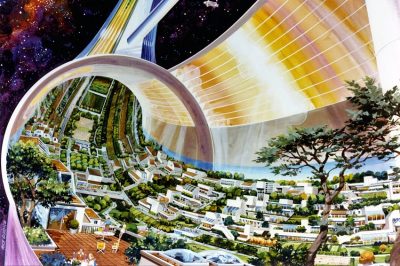Znamya Satellite: Russia’s Space Mirror Deflects Sunlight to Light up Arctic Region for Brief Period
Share

Znamya satellite. (QSI / MIR)
The Russian scientists planned to capture the sunlight on the space mirrors and deflect the same onto Earth during the night. The idea was to increase daylight hours in the Arctic regions of Russia and northern Europe. Also, the idea was to provide solar energy to people in these regions.
Znamya is the Russian word for a banner. It was a Russian satellite. The Space Regatta Consortium (SRC) had developed Znamya series under the Russian Space Mirror Project. A corporation named Energia was behind the SRC project.
The experiment with Znamya was not successful. That is why, SRC successfully deployed Znamya-2 on the night of February 4, in 1993. It carried a payload of space mirrors that had a 20m diameter. They were circular in form and had 5mm thickness. The space mirrors were made of aluminized PETF (Mylar) film that had an areal density of 22 g/2cm.
The mirrors were split into eight sections with gaps between them. The mirrors had an unfolding mechanism inside Progress M-15, a cargo space vehicle. Before deploying the space mirrors, Progress M-15 disengaged from MIR space station.
Znamya Satellite: Idea was to increase daylight hours
Znamya-2’s deployment of space mirrors was a success. True to its purpose, the space mirrors succeeded in deflecting the sunlight and lighted up the night sky for a brief moment. The redirected beam appeared brighter than the moon. The brightened area was 5 to 6 km wide.
Interestingly, the redirected beam passed across regions like the Atlantic Ocean, Europe, and Russia. How did the deflected sunlight appear to people on Earth? For some, it appeared like a bright star. For astronauts orbiting the Earth, it appeared like a pale light.
The experiment lasted a few days
The success of the Znamya-2 experiment can be looked from the feasibility of illuminating the earth during night time. However, the experiment lasted for a few days as the giant mirrors deorbited and went up in flames while re-entering the Earth’s atmosphere.
Following the partial success of Znamya-2 experiment, SRC conceived and developed Znamya-2.5. The idea was to deploy reflectors of 25m diameter. The design and materials used in Znamya-2.5 were similar to Znamya-2.
Znamya-2.5 had three chief goals
Znamya-2.5 had three chief goals: a) to validate improvements made in the film structure, b) to test the new light (Novy Svet) illumination capability, and c) to examine the stability of the film structure and the system.
SRC deployed Znamya-2.5 on February 4 of 1999. But, sadly, there was an error in the software and the mission operations due to which the whole reflector apparatus plunged into the ocean.
Ever since then neither Russia nor any other country experimented with solar mirrors. Had the Znamya experiment succeeded in all respects, the Russians planned to send dozens of space mirrors into Earth’s orbit.
Origins
The foundation for the Znamya experiment was laid in the 1980s, especially during the Cold War period. The Soviet Union military conceived of a new technology to wage space war against its enemies. At the same time, the Soviets desired to boost productivity in the cities and in farmland.
Znamya’s lead engineer was the maverick Vladimir Syromyatnikov, who was behind the spacecraft that propelled Yuri Gagarin into space in 1961. Syromyatnikov had a brilliant space engineering mind.
It was Syromyatnikov’s passion for solar sails that led to the Znamya experiment. But, after the Znamya experiment’s partial failure Syromyatnikov returned to the drawing board to improve the docking mechanisms for Znamya 3. But with no fresh funding forthcoming, his plans remained on the drawing board.
The costs involved in the Znamya experiment were sky high. The hardware costs alone of Znamya 2 were in the region of $10 million. For the Znamya 3 experiment, Syromyatnikov wanted funds in the region of $100 million. He believed that the Znamya experiment would turn profitable in three years only.
While Russia’s Znamya experiment was on, there were worldwide protests from diverse communities like environmentalists, scientists, astronomers and humanitarian groups.
Controversies
Astronomers slammed the experiment saying it would hinder space observation from Earth. Environmentalists said the absence of nighttime could cause physiological disorders like sleep deprivation among humans and animals.
Syromyatnikov’s Znamya experiment was a path-breaking one. Today, it’s near impossible for us to visualise the vision behind the experiment. The vision was to have multiple space mirrors in Earth’s orbit to regulate nightlife in a sleepless world.
Sadly, Vladimir Syromyatnikov, one of the greatest astronautical engineers in the world passed away in September 2006.
Enjoyed this article? Also, check out “Lost Cosmonauts of USSR: Did the Soviet Union Cover up its Secret Cosmonaut Casualties?“.
Fact Analysis:
STSTW Media strives to deliver accurate information through careful research. However, things can go wrong. If you find the above article inaccurate or biased, please let us know at [email protected]













